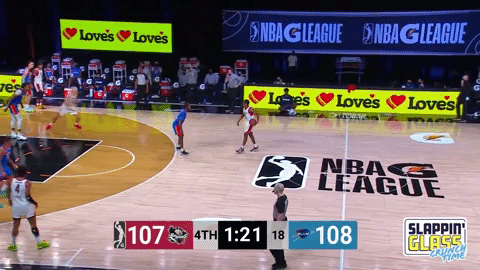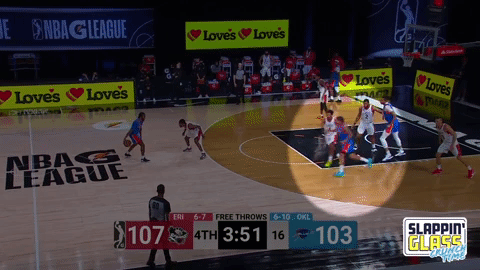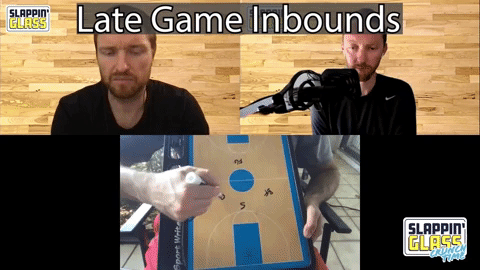Welcome to our “Sunday Mornin’ Newsletter”, where we explore basketball’s best ideas, strategies, and coaches from around the world.
Today’s edition will cover:
Slappin’ Glass Plus… Today’s Launch!
“Crunch Time” & EOG Strategy with Ryan Pannone
John Gallagher: Inside the Episode
Best Sets of the Week
Watch | Read | Quote
Let’s dive in…
Slappin’ Glass Plus… Launch Time
Slappin’ Glass Plus, our premium membership platform launched this past weekend! Thank you to all the coaches around the world who’ve signed up so far. We’re offering a 15% discount on the platform for Full-Year subscribers until May 30th.
We’ve spoken to many coaches about signing up their entire staffs as well. You can email us at info@slappinglass.com for the staff rates.
Here’s the link with all the information and where you can sign up for the platform…
Thanks for the support! Time to celebrate…
“Crunch Time” with Ryan Pannone
*Note: This section of the SMN will be free for everyone until May 30th, after which, it will only be available for SG Plus members. Non-members will still receive a lite version of the SNM for Free.
Along with the launch of SG Plus today, we’re also excited to release our second episode of the “Crunch Time” Series.
“Crunch Time” is a deep-dive film room session analyzing the last 4 minutes of a close game with a coach from that game. We had an absolute blast in our first episode with Johns Hopkins Head Coach, Josh Loeffler, and were excited to welcome back former podcast guest and one of the most respected coaches in the game, Ryan Pannone, Head Coach of the G-League’s Erie Bayhawks.
What we particularly love about analyzing “Crunch Time” situations, is that, due to the weightiness of decisions made at the end of games, the conversations usually flow right to the heart of a coach’s fundamental beliefs about offense, defense, Time-Out strategy, etc. In a tight game that matters, you don’t see coaches flippantly test-drive new plays or defensive coverages just to “see if it works” (unless it’s a 6pm summertime game in a back gym somewhere). Most often, when all the chips are on the table, coaches on both sides of the ball are running their most trusted schemes with their most trusted players, and the conversation surrounding those EOG decisions is a Pandora’s Box well worth opening.
For those who’ve ever heard Ryan Pannone speak on a podcast or at a clinic, know that he has a way of thinking and talking about the game that’s both insightful and digestible. Our “Crunch Time” episode is chalk-full of “Pannonisms”, and here we’ll focus on three distinct takeaways from our film-room session with him:
Provoking and Attacking Switches in Late-Game Possessions
Late-Clock “Ghost Screen” Coverage Philosophies
SLOB/BLOB Inbound Strategy & Timeout Usage
{ Provoking & Attacking Switches }
A couple weeks ago we detailed many of the ways that teams across the world attack a switching defense, and we also discussed this topic with this week’s podcast guest, John Gallagher (more on that below).
With the rise of switching, especially in late-clock situations, it’s a subject that’s on the minds of many coaches across the country as they head into the off-season. Coach Pannone has some great thoughts on attacking the switch, but before getting to that, we want to reflect on a part of our conversation where Coach Pannone talks about why and how he’ll try and provoke a switch in late-game situations.
As much as a switching defense can disrupt an offensive rhythm, it can also cause matchup problems for the defense. Coach Pannone discussed how they’ll actively try and manipulate a switch so they can play through a particular mismatch. In their “Crunch Time” win over OKC Blue, they used a “Reverse/Angled Ballscreen” to provoke a switch from the 1 and the 5.
With 16 seconds on the shot clock when the switch takes place, the case above gives the offense multiple ways to continue taking advantage of the mismatch for the rest of the possession. With the defensive 5-man now guarding the PG, they can “Boomerang” the ball back to the PG and let him operate against the 5, or they can continue flowing through their weakside action with the defensive 1-man now guarding the offensive 5, a situation he may not be used to guarding regularly.
About a minute later in the game, with under 30 seconds left, Coach Pannone runs the same Reverse Screen action to provoke the switch. This time, however, the PG keeps the ball and begins attacking their desired mismatch…
Attacking the Switch - “Flash Game”
Layered in our conversation about attacking switching defenses late in the game, Coach Pannone discussed his “Flash Game” concept and why he’ll be using it more going forward.
What is it? “Flash Game” is Coach Pannone’s term for a late-clock offensive scheme where a player “flashes” to the elbow area and, after the catch, the other players sprint immediately into some type of split/scissor/flare cut action. Here’s one example…
And here’s Coach Pannone drawing it up during the episode while we give him the same focused attention we give our wives when discussing color options for the pillows on the couch…
* “Flash Game” Philosophy: Of all the strategy discussed in the episode, this was one of the most intriguing and one we plan to continue exploring. Coach Pannone talked about “Flash Game” becoming an “end-of-clock” action he’ll continue to work on going into next season for a couple of reasons:
Defensive Familiarity with Middle PNR’s
As the use of PNR’s have become more prevalent at all levels of basketball, defenses have, in return, become much better at taking away the most advantageous elements of the late-clock Middle PNR, whether it’s through a switch, trap, hedge, or “Zoning It”. In the “ping-ponging” game of basketball innovation, it’s now the offenses’ serve to develop newer strategies for gaining an advantage late in the clock.
Splits, Scissors, and Flares are Hard to Guard
Flashing a player to the elbow and then getting immediately into Split or Flare action has multiple advantages for the offense in a late-clock scenario:
Makes in nearly impossible to double the ball
Makes it difficult to “load-up” in help if the ballhandler starts to operate 1 v 1
Puts a Defensive Big in a potential situation where they have to guard the split cuts instead of offering rim protection.
For a look at how Flare Action can be used against a switch, many teams in Europe are great at using late -clock flares to occupy the defense and find open looks for shooters…
{ “Square, Square, Square” - Defending the Ghost Screen }
Moving to the other side of the ball, Coach Pannone lent some terrific thoughts on guarding an action that has been one of the most popular in the world of late… the Ghost Screen.
We’ve covered it a bunch, and you can read all about it HERE, but, in short, the Ghost Screen (a “running slip”) is so popular in a late-game possession because it 1) Can cause confusion for the defense as to whether they should switch or get into their PNR coverage, and 2) greatly decreases the chance of an offensive foul being called on a Big setting the PNR.
To help simplify the coverage and communication between the two defenders involved in the “Ghost Screen”, Coach Pannone talked about their “Square” call coming from the defender guarding the “Ghost Screener”. Here’s a quick look…
*What does the“Square” call mean? What the defender guarding the “Ghost Screen” is communicating to the on-ball defender by yelling “Square, Square, Square”, is to keep their body and foot-angle “square” to the ball until they feel contact from a screen. If they do not feel any contact, they’re in great position to continue guarding the ballhandler as they attack downhill. If there is any contact, it’s a switch. Coach Pannone goes into greater detail in the episode about the nuts and bolts of this situation.
{ Late Game SLOB/BLOB Inbounds & Timeouts}
We discussed inbounding the ball against pressure in our first “Crunch Time” episode with Coach Loeffler, and returned to it again with Coach Pannone. Both coaches broke down the importance of spacing, timing, and having your best passers take the ball out of bounds. Coach Pannone drew up some of his favorite inbounds concepts during the episode…
Outside of the X’s and O’s, another interesting discussion we had with Coach Pannone centered around the usage of Timeouts in late-game inbounds situations.
Coach Pannone discussed the concept of “adding possessions” with timeouts and strategizing when/when not to use them during an inbounding situation. He talks us through some great scenarios in the episode, but, in short, instead of immediately calling a timeout after a made basket, Coach Pannone prefers to let his team set-up their “Press Break” and try and get the ball in right away. He has a “three count” in his head and if his team hasn’t successfully entered the ball after three seconds, he’ll then use the timeout to draw something else up. In the GIF below, the offense had just made a Free Throw to go down 1…
In the specific situation of the OKC Blue game, Coach Pannone had one timeout remaining and wanted to keep it in his pocket in case he needed it to advance the ball to half court later in the game.
*Note: Advancing the ball with a timeout is not something many levels of basketball are able to do, but the discussion around when, how, and why to use timeouts down the stretch is still highly applicable.
More Topics…
As mentioned earlier, Coach Pannone discusses plenty more thought-provoking topics in the episode including:
Fouling Up 3 — When and How
When to run your best plays
Outscoring your opponent by 10 points or more in any quarter, and its effect on that game’s winning percentage
Late-Game Shot Selection
And much more.
This episode is available today on Slappin’ Glass TV.
John Gallagher: Inside the Episode
It has been quite a rollercoaster ride for Hartford Men’s Basketball and Coach John Gallagher over the past couple of months. The story of Hartford University making the decision to transition from D1 to D3 a month after Coach Gallagher’s squad made their first NCAA Tournament appearance in school history has made national headlines. We were fortunate to sit down with Coach Gallagher this week on the podcast to dive into how he’s leading his team through the current situation, as well as nerd out on 1-3-1 Zones, Switching Defenses, attacking a switch, and an all-time classic segment of “Start, Sub, or Sit?!” As you’ll hear in the episode, Coach Gallagher is a ton of fun to listen to and has some unique and powerful perspectives on building culture and community.
Some topics we highlight include:
Leading through adversity
How he is handling the current situation and what he’s learned about himself as a leader
Late-Clock and Late-Game 1-3-1 Zoning
A really fun conversation about the risks/rewards of running a 1-3-1 Zone in certain situations. Coach Gallagher breaks down some of the rules and philosophies of their 1-3-1 Zone.
For SG Plus members, Coach Gallagher graciously provided his personal teaching notes on their 1-3-1 Zone. It’ll be available in the “Coaches Corner” community.
Attacking the Switch
We talk Flares and Slips in Late-Clock situations
“Start, Sub, or Sit?!”
There’s a lot in this segment lol
“The Neighborhood” and Building Community
How he’s built a community around the “Neighborhood” in Hartford and advice for coaches wanting to build their own
Here’s a link to listen to the entire episode…
Best Sets of the Week
Some of the best we saw from the weeks that was, including Parma (VTB League), SLAM Ostrow (Poland), Manresa (Spain) and Levallois (France).
Watch | Read | Quote
Watch:
The WNBA
Levallois (French Pro-A)
BC Zenit (Russia/Euroleague)
Read:
From the Ringer: If You Thought Playing Defense Was Hard, Try Quantifying It
From Inc.com: 14 Things About Life Everyone Should Know
From HBR: The Most Important Leadership Competencies, According to World Leaders
Quote:
“A team isn’t a bunch of kids out to win; a team is something you belong to, something you feel, something you have to earn.” - Gordon Bombay, The Mighty Ducks
If you enjoyed this newsletter, we always appreciate a share with others you think would find value in it.
Thank you for reading and have a great week coaching,
Dan and Pat












